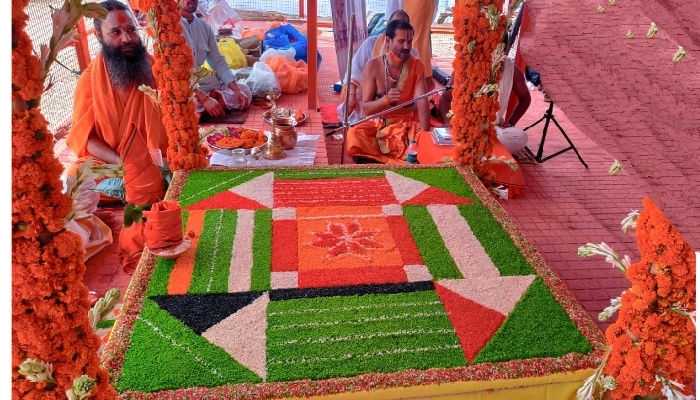Mahasamund, Nov 18: Prime Minister Narendra Modi on Sunday alleged that Sitaram Kesri, who was from a "Dalit and exploited community", was not allowed to complete his term as the Congress president so that Sonia Gandhi could take over the reins of the party.
Speaking at a poll rally here in Chhattisgarh, Modi claimed that Kesri was ousted unceremoniously, "was locked in a bathroom" and "thrown out on the footpath".
"The Congress had said a chaiwala became the prime minister by the grace of Pandit Jawaharlal Nehru. I challenged them (to show that) when he (Nehru) had established such a democratic and liberal system, then make someone from outside the Gandhi family the Congress president for at least five years," he said.
"The country knows that Sitaram Kesri, who was from a Dalit and exploited community, was not allowed to complete his five-year term as the Congress president and was removed from the post," Modi added.
"The country knows how he was locked in a bathroom and then, thrown out of office and on the footpath to facilitate the entry of Sonia Gandhi as the new party chief," he said.
"The Congress cannot even afford a Dalit and exploited leader as its president for two years, then how can they appoint someone, who is not from the Gandhi family, for five years," he added.
The prime minister was addressing a rally here on the last day of campaigning for the second and final phase of the Chhattisgarh Assembly polls.
Targeting the Gandhi family, he said in the past, "Delhi had a remote-controlled government".
"The remote was in the hands of a family, which was afraid of the BJP," he added.
"Remember the days when four generations of a family ruled the country. What was the fate of the people? They only thought about the welfare of one family but never about the welfare of people. How can we trust them to fulfil the aspirations of people now," Modi said.
He praised the high voter turnout in the Bastar region of the state in the first phase of polling on November 12 and also in the panchayat polls in Jammu and Kashmir.
"Despite being threatened by Naxals with guns and bombs, a huge voter turnout was recorded in Bastar. The poor tribals have shown faith in democracy and given a befitting reply to bombs and guns," Modi said.
"Yesterday, panchayat elections were held in Kashmir. Earlier, people (the rulers) used to avoid conducting polls there. After the governor's rule was imposed, we decided that the power of Kashmir should rest in the hands of the people of Kashmir," he added.
"Terrorists had given a call for a shutdown in Kashmir, but look at the faith of the Kashmiri people in democracy, a voter turnout of around 60-70 per cent was recorded. It is a slap on the face of separatism and terrorism. They (people) have shown the strength of democracy," Modi said.
Jammu and Kashmir recorded 74.1 per cent polling in the first phase of the panchayat polls in 47 blocks Saturday.
"The doors have been opened for the welfare of Kashmir. Who had stopped the Congress from doing this earlier? They played backdoor games with terrorists which will not be allowed anymore. We took courageous steps one by one," the prime minister said.
He targeted Congress chief Rahul Gandhi over farm loan waiver, an issue that has taken centrestage in the Chhattisgarh polls.
"As elections approach, the Congress plays a game of promises. But they cannot mislead the country anymore. They must answer what did they do for the welfare of our farmers when they ruled for four generations.
"They kept the farmers in a pathetic condition during their 50-year rule. Had they strengthened the farmers, fulfilled their requirements, our farmers would have been prosperous," Modi said.
"They are making false promises of loan waiver to the people of Chhattisgarh. The same promise was made to farmers during the Karnataka polls, but even after around a year has passed, the promise is yet to be fulfilled.
"Instead, the government is issuing warrants and arresting the farmers whose debts are outstanding," he added.
Praising the Bharatiya Janata Party (BJP) government under Raman Singh in Chhattisgarh, Modi said it ensured soil health cards for 75 lakh farmers, adding in a sarcastic vein that the Congress had failed to provide health cards to even humans.
"Though the Raman Singh government is in power in the state for the last 15 years, it got the actual opportunity to work for the welfare of the state after the NDA government came to power...Raman Singh had to fight for the rights of the state with the Congress government at the Centre," he said.
Singh had sought support from the then Congress-led United Progressive Alliance (UPA) government to fight Naxals, but the "remote-controlled" government behaved as if Chhattisgarh did not exist, the prime minister said.
He added that if the BJP government under Singh remained in power for another 10-15 years, Chhattisgarh would feature among the top three developed states in the country.
"Chhattisgarh has turned 18. This is a very crucial phase for the state. Just like parents care for the future of their children when they turn 18, I urge the people of the state to think about the welfare of the state and once again give Raman Singh a chance to serve," Modi told the crowd.
The final phase of the Chhattisgarh polls, covering 72 Assembly seats, will be held on November 20. The first phase of polling for 18 seats was held on November 12. The results will be announced on December 11.





Comments
Mr.Jumble baaj
There are so many side lined leaders like advani, murali manohar josh, yashoda behn and many more.
So what will you will say
Add new comment